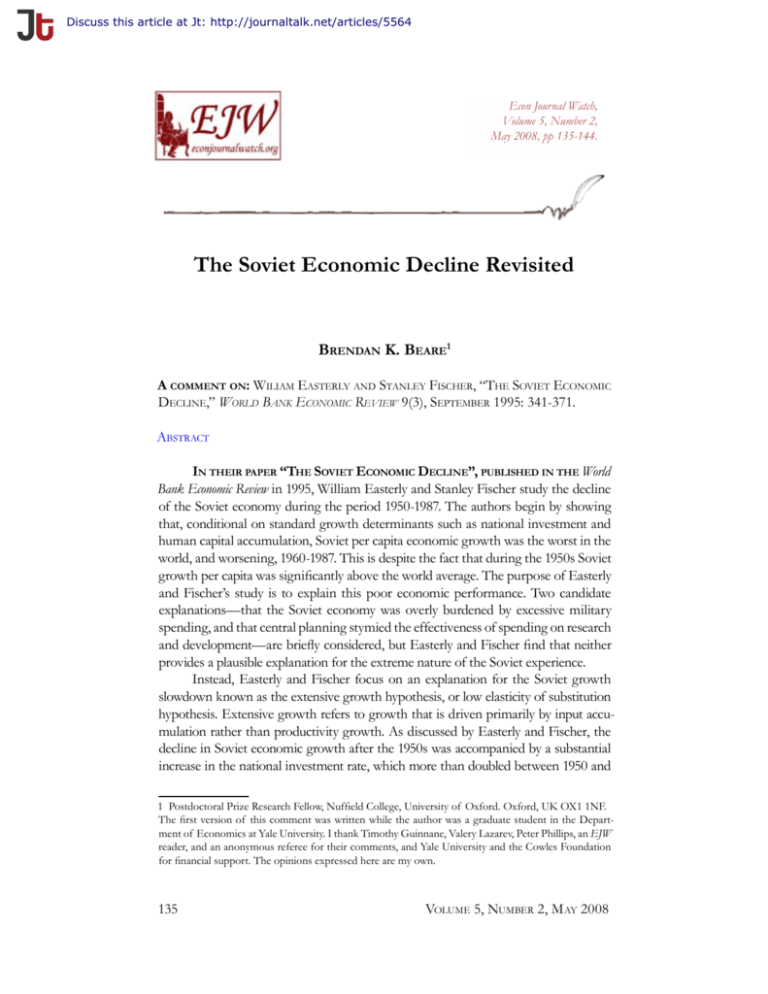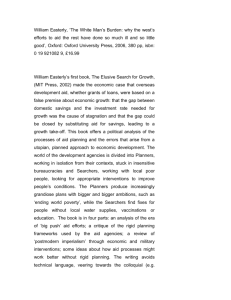The Soviet Economic Decline Revisited
advertisement

Discuss this article at Jt: http://journaltalk.net/articles/5564 Soviet Economic Decline Econ Journal Watch, Volume 5, Number 2, May 2008, pp 135-144. The Soviet Economic Decline Revisited Brendan K. Beare1 A comment on: Wiliam Easterly and Stanley Fischer, “The Soviet Economic Decline,” World Bank Economic Review 9(3), September 1995: 341-371. Abstract In their paper “The Soviet Economic Decline”, published in the World Bank Economic Review in 1995, William Easterly and Stanley Fischer study the decline of the Soviet economy during the period 1950-1987. The authors begin by showing that, conditional on standard growth determinants such as national investment and human capital accumulation, Soviet per capita economic growth was the worst in the world, and worsening, 1960-1987. This is despite the fact that during the 1950s Soviet growth per capita was significantly above the world average. The purpose of Easterly and Fischer’s study is to explain this poor economic performance. Two candidate explanations—that the Soviet economy was overly burdened by excessive military spending, and that central planning stymied the effectiveness of spending on research and development—are briefly considered, but Easterly and Fischer find that neither provides a plausible explanation for the extreme nature of the Soviet experience. Instead, Easterly and Fischer focus on an explanation for the Soviet growth slowdown known as the extensive growth hypothesis, or low elasticity of substitution hypothesis. Extensive growth refers to growth that is driven primarily by input accumulation rather than productivity growth. As discussed by Easterly and Fischer, the decline in Soviet economic growth after the 1950s was accompanied by a substantial increase in the national investment rate, which more than doubled between 1950 and 1 Postdoctoral Prize Research Fellow, Nuffield College, University of Oxford. Oxford, UK OX1 1NF. The first version of this comment was written while the author was a graduate student in the Department of Economics at Yale University. I thank Timothy Guinnane, Valery Lazarev, Peter Phillips, an EJW reader, and an anonymous referee for their comments, and Yale University and the Cowles Foundation for financial support. The opinions expressed here are my own. 135 Volume 5, Number 2, M ay 2008 Brendan K. Beare 1987. Similar increases in the investment rate were experienced in a number of newly industrializing East Asian economies, including Japan and Korea. Whereas extensive growth via capital accumulation led to rapid economic growth in much of East Asia, the rising investment rate in the Soviet economy was accompanied by a declining rate of growth. The extensive growth hypothesis, proposed earlier by Weitzman (1970), posits that this decline was due to sharply diminishing returns to capital brought about by a low elasticity of substitution between capital and labor. Easterly and Fischer argue that the elasticity of substitution was indeed much lower in the Soviet economy than in the newly industrializing East Asian economies, and suggest that the difference may be fundamentally related to the contrasting nature of planned and market economies. The model of the Soviet economy used by Easterly and Fischer is a constant elasticity of substitution (CES) growth equation: lnYt = d0 + d1t50−59 + d2 t60−69 + d3 t70−79 + d4 t80−87 + € g ln aK t(g −1) /g + (1− a ) L(tg −1) /g g −1 [ ] (1) This is labeled as equation 6 in Easterly and Fischer’s paper (with ln Lt subtracted from both sides of the equation). In each period t, Yt denotes output, Kt denotes capital, and Lt denotes labor. t50-59 is equal to the product of t and a dummy variable that is equal to one in periods corresponding to the years 1950 to 1959, and equal to zero in other periods. The other trend variables are defined similarly. The parameters a, g ∈ (0,1) correspond to the share of capital in production and the elasticity of substitution between capital and labor. The log of technology, assumed by Easterly and Fischer to be Hicks-neutral, is equal to the sum of the first five terms on the right hand side of (1). Thus, d1 through d4 represent decade-specific rates of technical change. The purpose of the decade-specific trend functions is to allow for a modicum of flexibility in the evolution of technological progress over the sample period. Easterly and Fischer seek to appraise the extensive growth hypothesis by empirically estimating (1) using nonlinear least squares. In a CES model of economic growth, an elasticity of substitution below one implies decreasing returns to capital accumulation. Thus, an estimate of g significantly (in both the statistical and the economic sense) below one would provide support for the extensive growth hypothesis. Relatively constant estimates of d1 through d4 would provide further support for the extensive growth hypothesis, by showing that the bulk of the decline in Soviet growth can be explained by decreasing returns to capital accumulation. An estimate of g close to one, and declining estimates of d1 through d4, would provide evidence against the extensive growth hypothesis. Empirical estimation of (1) is complicated by the relatively poor quality of data for the Soviet economy during the period in question. Easterly and Fischer consider several annual datasets spliced together by Gomulka and Schaffer (1991) Econ Journal Watch 136 Soviet Economic Decline from various sources.2 Three main sources are involved: a dataset constructed by the U.S. Central Intelligence Agency (CIA), a dataset constructed by the Russian economist Khanin, and the official Soviet statistics.3 Easterly and Fischer report estimates of (1) using the CIA data at the total economy and industrial sector levels. They also discuss briefly the results obtained using the other datasets. The results of Easterly and Fischer’s analysis using the CIA total economy data are displayed in the column labeled EF in Table 1. These estimates are taken from Table 6 in their paper. Using the original data and the equation they specified,4 I attempted to derive the same estimates. My own estimates are displayed in the column labeled EF* in Table 1. The figures in columns EF and EF* are similar, but not identical. Without the precise details of the numerical optimization routine used by Easterly and Fischer, or access to the code used to generate their results, it is difficult to know exactly why the figures differ. Note that the R-squared values in columns EF and EF* are extremely close to one another. See McCullough and Vinod (2003) for a discussion of numerical discrepancies arising from differences between econometric software packages and optimization settings. The figures in column EF* were obtained by performing a grid search over the nonlinear parameters g and a, running from 0.01 to 0.99 in increments of 0.01, and estimating the other parameters by linear regression conditional on g and a at each point in the grid. This approach was used to avoid the sensitivity of results to the choice of starting values in more sophisticated optimization routines, a problem which appears to be substantial in this instance. The estimates in column EF appear to provide striking support for the extensive growth hypothesis. The estimated elasticity of substitution is 0.37; well below one. Moreover, the estimated standard error for this parameter is only 0.04. The capital share parameter is estimated at 0.96, with a standard error of only 0.01. This estimate seems extremely high, even in view of the intensive capital accumulation in the Soviet economy during the sample period. The rates of technical change are less precisely estimated than the other parameters, but it is notable that they do not appear to decline over the sample period. The same qualitative statements hold true for our own estimates reported in column EF*. 2 The data are downloadable from the World Bank website: www.worldbank.org. 3 The CIA data are at the level of the whole Soviet economy, and at the level of the Soviet industrial sector. Khanin’s data are at the level of the material sector – roughly speaking, that part of the economy that produces material goods – while the official statistics are at the material and industrial sector levels. 4 All computations in this comment were carried out using Ox version 5.00. Ox is free for academic use and may be downloaded from www.doornik.com. The .ox files used to generate the results in Tables 1 and 2, and suitably formatted data files, may be downloaded from www.nuff.ox.ac.uk/users/beare/ soviet. **As of 2014, the data and code may be downloaded from http://econjwatch.org/file_download/803/BeareDataAndCodeMay2008.zip 137 Volume 5, Number 2, M ay 2008 Brendan K. Beare Table 1: Parameter Estimates for the Soviet Production Function, 1950-1987 Parameter (or statistic) Elasticity of substitution (g) Capital share (a) % rate of technical change, 1950-59 (100 d1) % rate of technical change, 1960-69 (100d2) % rate of technical change, 1970-79 (100d3) % rate of technical change, 1980-87 (100d4) R2 Durbin-Watson statistic EF 0.37 (0.04) 0.96 (0.01) Estimate (or value) EF* CIA KHA 0.38 0.75 0.99 (0.05) (0.59) (2.20) 0.96 0.53 0.82 (0.02) (0.53) (0.19) OFF 0.04 (0.02) 0.82 (0.15) 1.09 0.99 2.90 2.47 0.76 (0.32) (0.33) (1.14) (0.38) (0.21) 1.10 0.95 1.35 -0.34 5.63 (0.35) (0.43) (0.67) (0.51) (0.15) 1.16 1.08 0.61 -0.48 4.18 (0.36) (0.43) (0.96) (0.44) (0.10) 1.09 0.97 -0.14 -0.02 2.60 (0.34) 0.9987 1.9228 (0.40) 0.9988 1.9183 (1.08) 0.9983 1.5715 (0.12) 0.9990 1.4647 (0.15) 0.9995 1.4334 Note: Estimated standard errors in parentheses. EF: Easterly-Fischer estimates based on CIA total economy data, equation (1); EF*: Author’s estimates based on CIA total economy data, equation (1); CIA: Author’s estimates based on CIA total economy data, equation (2); KHA: Author’s estimates based on Khanin material sector data, equation (2); OFF: Author’s estimates based on official material sector data, equation (2). The results obtained by Easterly and Fischer using the other datasets are mixed. Specifically, Easterly and Fischer claim to find support for the extensive growth hypothesis in the industry-level CIA data and in the material sector and industry-level official data, but no support in the Khanin data. The results obtained using the official data and the Khanin data do not appear in the version of their paper published in the World Bank Economic Review, but they may be found in two earlier working papers (1994a, 1994b). Unfortunately, the results of Easterly and Fischer’s study are faulty because their equation is faulty. By allowing the slope coefficients d1 through d4 to vary across decades while holding the intercept d0 fixed, Easterly and Fischer allow changes in the rate of growth of technology to become confused with changes in the level of technology. In particular, any decline in the rate of growth of technology between decades must necessarily be accompanied by a sudden decline in the level of technology. Figure 1 illustrates the problem. In panel (a), we have a graph of the equation Econ Journal Watch 138 Soviet Economic Decline while in panel (b), we have ⎧1 + 2 x x < 1 y=⎨ ⎩ 1 + x x ≥ 1, ⎧1 + 2 x x < 1 y=⎨ ⎩ 2 + x x ≥ 1. Figure 1: Two Piecewise Linear Functions 4 4 3 3 2 2 1 1 0 0 0 1 (a) 2 0 1 (a) (b) (b) The function graphed in (a) drops discontinuously when the slope decreases, whereas the function graphed in (b) does not. The example is banal, but it makes the point: If one wants to write down an equation for a continuous piecewise linear trend, one needs to allow the intercept term to vary along with the slope term. Easterly and Fischer’s specification of the log-technology process is of the kind shown in panel (a). This is a serious deficiency because, if the data does not support a sudden decline in the level of technology at the end of each decade,5 then estimated parameters will be less likely to reflect a decline in the rate of growth of technology, even if such a decline does match the data well. It seems safe to assume that this was not Easterly and Fischer’s intention. A more appropriate specification for the production function, presumably 5 Using the CIA total economy data, a Wald test of the hypothesis that the intercept term in equation (1) is constant, versus the alternative hypothesis of an intercept that may vary between decades, yields a p-value of less than 0.01. 139 Volume 5, Number 2, M ay 2008 2 Brendan K. Beare consistent with the intended model of Easterly and Fischer, is ln Yt = d 0 + d 1tD50 −87 + (d 2 − d 1 )(t − 10) D 60 −87 + (d 3 − d 2 )(t − 20) D 70 −87 + (d 4 − d 3 )(t − 30) D80 −87 + g ln[aK t(g −1)/ g + (1 − a )L(tg −1)/ g ]. g −1 (2) Here, D50-59 represents a dummy variable that is equal to one during 1950-59 and zero during other years. The other dummy variables are also defined in the obvious way. This specification allows for a technology process with a rate of growth that varies across decades, but without inducing a sudden change in level. In other words, it is of the kind shown in panel (b) of Figure 1. Estimating equation (2) with the data used by Easterly and Fischer gives results very different from those obtained by estimating equation (1). These results are presented in the columns labeled CIA, KHA and OFF in Table 1. The three columns refer respectively to the CIA total economy data, the Khanin material sector data, and the official material sector data. Again, the estimates are obtained by employing a grid search over the nonlinear parameters g and a. Let us first compare the results in columns EF and CIA, as these columns correspond to the estimation of equations (1) and (2) respectively, using the same data. The most obvious difference between the two sets of results is that the estimated standard errors are far larger in the latter. The estimated standard error on the elasticity of substitution using equation (2) is so large that we can say almost nothing about the magnitude of this parameter with any confidence. The estimates for d1 through d4 are more interesting, and suggest a monotone decline in the rate of technical change. The Wald statistic corresponding to the hypothesis d1 = d2 = d3 = d4 has a p-value of 0.03, and so the hypothesis of a constant rate of technical change can be rejected at the 5% significance level. The Durbin-Watson statistic corresponding to the results in column CIA of Table 1 is 1.57. This number is neither high enough nor low enough for us to be clear about whether serial correlation in the residuals presents a serious problem. Column CIA in Table 2 presents the results that were obtained when the production function was re-estimated with a correction for first order autocorrelation in the residuals, again using the CIA total economy data. Estimation for this column, and for the other columns of Table 2, was performed using a grid search over g, a, and the autocorrelation coefficient. The results in column CIA are generally similar to those obtained without correcting for autocorrelation, but the estimated standard errors are even larger. None of the estimated parameters are statistically significant. The Wald statistic corresponding to the hypothesis d1 = d2 = d3 = d4 now has a p-value of 0.096. In sum, the data tells us almost nothing other than that the rate of technical change appears to be declining over the sample period. Econ Journal Watch 140 Soviet Economic Decline Table 2: Parameter Estimates for the Soviet Production Function, 19501987, Using a First-order Correction for Autocorrelation Parameter or statistic Elasticity of substitution (g) Capital share (a) % rate of technical change, 1950-59 (100d1) % rate of technical change, 1960-69 (100d2) % rate of technical change, 1970-79 (100d3) % rate of technical change, 1980-87 (100d4) Autocorrelation coefficient R2 Durbin-Watson statistic Estimate or value CIA KHA OFF 0.55 (0.65) 0.75 (0.78) 2.52 (1.64) 1.48 (1.08) 0.97 (1.69) 0.27 (1.63) 0.23 (0.19) 0.9982 1.9413 0.99 (2.78) 0.84 (0.22) 2.26 (0.46) -0.40 (0.59) -0.53 (0.51) 0.02 (0.15) 0.18 (0.24) 0.9989 1.7705 0.04 (0.02) 0.85 (0.16) 0.48 (0.32) 5.61 (0.18) 4.18 (0.13) 2.61 (0.18) 0.25 (0.17) 0.9995 2.0741 Note: Estimated standard errors in parentheses. CIA, KHA, OFF defined as in Table 1. Next, consider the results obtained when we estimate equation (2) using the Khanin material sector data. These results are given in column KHA of Table 1 when we do not correct for autocorrelation, and column KHA of Table 2 when we do. In Table 1, the estimated elasticity of substitution is 0.99, with a standard error of 2.20. This is for a parameter that is expected to be between zero and one. When we correct for autocorrelation—the Durbin-Watson statistic is again ambiguous—the estimated elasticity remains at 0.99, and the standard error increases to 2.78. Essentially, given the model we are estimating, Khanin’s data tell us close to nothing about the elasticity of substitution. They do tell us that the rate of technical change appears to be significantly higher in the 1950s than in subsequent decades. The null hypothesis of a constant rate of technical change can be rejected using a Wald test at any reasonable significance level, whether or not we correct for autocorrelation. Finally, consider the results obtained when we estimate equation (2) using the official material sector data. These results are given in column OFF of Tables 1 and 2, depending again on whether we include a correction for serial correlation. The effect of correcting for serial correlation is minor: in both cases, the 141 Volume 5, Number 2, M ay 2008 Brendan K. Beare estimated elasticity of substitution is 0.04, with a standard error of only 0.02. The estimated rate of technical change is low in the 1950’s, increasing sharply in the 1960’s, and then declining over the remainder of the sample. A constant rate of technical change can easily be rejected at any reasonable significance level. The extremely low estimate of the elasticity of substitution using the official material sector data is surprising, especially in view of the results obtained using the other data sets. It is worth bearing in mind that, as noted by Easterly and Fischer, the official Soviet data for this sample period are widely believed to be misreported. I have not reported estimation results based on the CIA or official data at the industry level because they suffer from an acute autocorrelation problem: with both datasets, the Durbin-Watson statistic is less than 0.52. Further analysis suggests that the residual process for equation (2) using the industry-level datasets may lack mean reversion. The results we have reported in the CIA, KHA and OFF columns of Table 1 and Table 2 reveal very little about the nature of the Soviet economy during the sample period. There is evidence that the rate of technical change was declining over the sample period, but we can say almost nothing about the elasticity of substitution or capital share parameters. The standard errors, and the discrepancies between data sets, are simply too large. This should not be surprising. Even if we ignore the poor quality of available data, estimation of a nonlinear model such as (2) using only thirty-eight observations, with a trend term that changes slope every ten periods, would seem to be extremely ambitious. The apparent support provided to the extensive growth hypothesis by the results reported by Easterly and Fischer is clearly nothing more than an artifact of their inappropriate trend specification. What is surprising is that the defect in Easterly and Fischer’s analysis has not been noted previously. It has been more than a decade since the paper in question appeared in the World Bank Economic Review. As of January 2008, a search of the Social Sciences Citation Index yields 41 citations of the paper (including the working paper versions). None of those 41 papers note the error. Many refer specifically to Easterly and Fischer’s claim that the elasticity of substitution between capital and labor in the Soviet economy was significantly below one. The simple error we have identified in Easterly and Fischer’s paper brings to mind McCullough’s (2007) discussion of the need for economics journals to ensure that published empirical studies are replicable; see also McCullough, McGeary and Harrison (2006). McCullough argues that the authors of published empirical studies should be required by journals to deposit data and code files into journal archives. Presumably, this practice should help to ensure against inaccuracies in published work. Yet, as noted earlier, the data used by Easterly and Fischer are publically available on the World Bank’s website. While code has not been made available, this seems relatively harmless given the straightforward and familiar nature of the econometric techniques employed. The point illustrated Econ Journal Watch 142 Soviet Economic Decline in Figure 1 is trivial; the problem with Easterly and Fischer’s trend specification would be obvious to anyone attempting to reproduce their results, or even just taking a careful look at equation (6) in their paper. It would seem that, despite the public accessibility of Easterly and Fischer’s data, no researcher has felt the need to take a closer look at the striking empirical results reported in their study. R eferences Easterly, William, and Stanley Fischer. 1994a. The Soviet Economic Decline: Historical and Republican Data. Policy Research Working Paper Series No. 1284. Washington: World Bank. Easterly, William and Stanley Fischer. 1994b. The Soviet Economic Decline: Historical and Republican Data. NBER Working Paper No. 4735. Cambridge, MA: National Bureau of Economic Research. Easterly, William and Stanley Fischer. 1995. The Soviet Economic Decline. World Bank Economic Review 9(3): 341-371. Gomulka, Stanislaw and Mark Schaffer. 1991. A New Method of Long-Run Growth Accounting, with Application to the Soviet Economy 1928-87 and the US Economy 1949-78. Center for Economic Performance Discussion Paper No. 14. London: London School of Economics and Political Science. McCullough, B. D. 2007. Got Replicability? The Journal of Money, Credit, and Banking Archive. Econ Journal Watch 4(3): 326-337. Link. McCullough, B. D., Kerry Anne McGeary and Teresa Harrison. 2006. Lessons from the JMCB archive. Journal of Money, Credit and Banking 38(4): 1093-1107. McCullough, B. D. and H. D. Vinod. 2003. Comment: Econometrics and Software. Journal of Economic Perspectives 17(1): 223-224. Weitzman, Martin L. 1970. Soviet Postwar Economic Growth and CapitalLabor Substitution. American Economic Review 60(5): 676-692. 143 Volume 5, Number 2, M ay 2008 Brendan K. Beare A bout the Author Brendan Beare is a Postdoctoral Prize Research Fellow at Nuffield College, University of Oxford. He received his Ph.D. from Yale University in 2007. His primary field of research is econometric theory. His email is brendan.beare@ nuffield.ox.ac.uk. Go to reply by Easterly and Fischer Go to May 2008 Table of Contents with links to articles Go to Archive of Comments Section Econ Journal Watch Discuss this article at Jt: http://journaltalk.net/articles/5564 144







